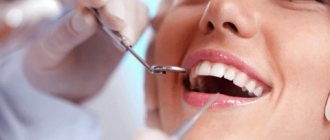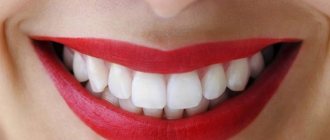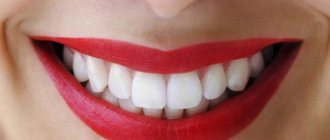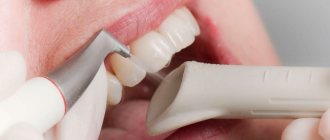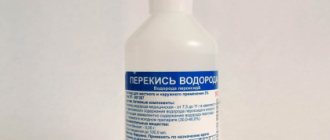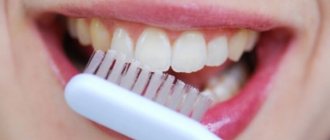Indications and contraindications Types After At home Is it harmful?
For children and pregnant women Differences from remineralization Effect Care after the procedure Fluoridation of teeth
- an effective way to protect teeth from caries and strengthen the enamel structure with the help of certain fluoridated agents.
Fluorine is an important element for the body; the daily requirement for it is about 3 mg. It comes to us with water and some food products. If it is not enough, then the connection between calcium compounds concentrated in the enamel is destroyed, the surface becomes vulnerable, which leads to increased sensitivity and damage to the tooth tissue.
Indications and contraindications
Indications for fluoridation of teeth in dentistry:
- increased sensitivity of enamel, reaction to cold, hot, sour and sweet foods;
- susceptibility to caries disease, as a preventive measure for caries;
- after using braces and other orthopedic structures;
- lack of fluoride;
- after teeth enamel whitening.
Contraindications for the procedure when there is only harm from fluoridation:
- allergy to fluoride-containing drugs;
- excess fluoride in drinking water;
- fluorosis (change in tooth color due to oversaturation of fluoride from childhood).
Covering teeth in children: basic methods and their features
Children's teeth are often exposed to such unpleasant and rather dangerous diseases as caries and pulpitis. And not immune from
This is not a single child.
The enamel of a child's tooth is very thin and cannot fully withstand aggressive influences. For example, at night the child ate and fell asleep, and the bacteria ingested with food negatively affect tooth enamel until the morning. This pressure on a child’s teeth over a long period of time causes the development of “bottle caries.” What to do? How to protect your child's teeth? An excellent solution to this problem is offered by dentists at the Beryozka clinic in Balashikha and the medical clinic in Zheleznodorozhny - complete protection of children’s teeth by coating them with special preparations.
Types of fluoridation
There are two types of fluoridation: superficial and deep fluoridation of teeth.
Simple fluoridation of teeth
There are three simple methods used in dentistry:
- applying fluoride varnish to the tooth surface with a brush
. An invisible film is created. The procedure is repeated several times. The cost of fluoridation with varnish is affordable for everyone. Despite the fact that fluoride varnish therapy has been used for a long time, the remedy is still working and relevant. - electrophoresis
.
Better tissue permeability for fluoride molecules is achieved with small electrical pulses. At the first stage, electrodes impregnated with 10% calcium are attached to the teeth, at the second, this action occurs with sodium fluoride 2-4%. 10 procedures
are usually enough. - individual mouth guards
filled with a fluoride-containing preparation.
They are made quickly during a visit to the dentist, an impression is taken and the trays harden to the shape of the patient’s teeth. The material is elastic. The doctor fills the trays with a solution containing a photor. The patient puts them on for 5-10 minutes. 10 procedures
are recommended .
Deep fluoridation of enamel and dentin
A simple method is superficial; fluorine particles are large and cannot penetrate deeply. Deep fluoridation of teeth uses a solution of magnesium fluoride silicate whose molecular size is so small that the product acts deeper in the tissues, enriching them with a higher concentration of fluoride. Fluorine and calcium create strong crystalline bonds. At the end of the procedure, the teeth are coated with a “sealing” preparation. Fluoride compounds remain under it for a year and a half.
Conduct deep fluoridation up to twice a year
, not more often. The effect of this method compared to the simple one is 5 times higher.
Why coat your teeth with fluoride varnish?
To keep your teeth strong and healthy for as long as possible, it is important to take proper oral care. Only an integrated approach to hygiene can give the desired effect, and in this regard, one of the conditions is regular prevention of caries and other dental diseases - prof. hygiene in the dentist's office. As part of this procedure, the specialist removes plaque and hardened deposits, and also covers the enamel with special fluoride-containing preparations to saturate the dental tissues with useful minerals and trace elements.
Every day, enamel is exposed to aggressive attacks from bacteria, exposure to acids, sugars and dyes contained in food, and temperature changes in food and drinks. This is why teeth are coated with fluoride varnish - this treatment allows you to protect the enamel from all of the above factors, strengthen it, saturate it with useful components, and prevent the development of caries and other pathological processes.
Essence and principle of operation
Fluoride varnish is a special product designed to strengthen and restore enamel. Its application to the enamel ensures complete enrichment of hard tissues with minerals important for their health. As a result, a reliable protective layer is formed on the surface, which for some time after application will contribute to the restoration of teeth and their saturation. The product is applied after removing plaque and deposits, as a result of which the smile acquires natural whiteness and shine - you can evaluate the result from the photo before and after varnishing.
The photo shows the teeth before and after using the drug.
Fluoride varnish is used as part of a comprehensive prof. hygiene, which is recommended for all people to undergo every six months. However, a course of fluoridation is often prescribed as an independent maintenance therapy, prevention, necessary in the presence of problems with enamel, for example, with hyperesthesia, that is, increased sensitivity.
Composition and properties of the solution, pros and cons
The main component of fluoride varnish is sodium fluoride. To enhance the effectiveness of the product, shellac, ethyl alcohol, chloroform and fir balsam1 are also added to its composition. A correctly selected combination of active substances allows you to achieve the following results:
- restoration of the density and structure of dental tissues,
- providing reliable protection from external aggressive factors,
- suppression of the growth of pathogenic microflora,
- effective prevention of dental diseases.
Fluoride-containing varnish is a liquid substance of sufficient thickness and with a specific pine smell. The product is absolutely safe for the body, but only a specialist can prescribe fluoridation after examination. In some regions of Russia, the concentration of fluoride compounds in tap water greatly exceeds permissible standards. Experts warn: residents of these regions should be careful with hygiene products containing fluoride - their use can lead to the opposite effect.
The product is absolutely safe for the body
Is it possible to do fluoridation at home?
The price of dental fluoridation in Moscow using the deep method will cost 2000-3000 rubles (all teeth), but you can do it yourself. Preparations for fluoridation at home are freely sold in pharmacies and specialized stores.
- Fluoride varnish
. Follow strictly the instructions, which indicate how and how many times to apply fluorine-containing varnish. - Therapeutic and prophylactic pastes and gels
. The composition should contain sodium fluoride, amino fluoride and other fluorides. We must remember that you cannot use such a paste for a long time so that there is no excess of fluoride in the body. Be sure to alternate with other types.
For effective fluoridation, it is better to consult with your dentist about choosing medications for home use. The result will be more lasting if you have professional teeth cleaning done beforehand to remove plaque and tartar.
Properties, benefits for teeth, indications for use and cost of enamel fluoridation
For complete prevention of dental diseases, prof. Hygiene must be carried out every six months. This is a comprehensive approach to protecting enamel from the influence of adverse factors, and one of its aspects is the saturation of teeth with fluoride. Fluoride varnish coating helps protect hard tissues from uncontrolled growth of pathogenic microflora, intense plaque and deposit formation. Read more about what fluoride varnish is, why they cover teeth, and how much such a service costs in dentistry later in this article.
Differences from remineralization
Any method of dentin fluoridation is part of remineralization, artificial saturation of the enamel structure with micro- and macroelements by applying dental pastes, gels rich in calcium, fluorine, phosphorus, magnesium, zinc, etc. to the surface. The procedures have the same goal - prevention of caries, strengthening of enamel and replenishment microelements lost during demineralization. If pastes and gels for remineralizing dental tissue contain several components, then fluoridation agents contain fluoride ions.
Fluoridation increases the rate of remineralization several times. Since fluoride varnish seals dentinal tubules, the use of mineral complexes should be separate. First, remineralization, the final stage is fluoridation of teeth.
What will the effect be and how long will it last?
The visual effect will be noticeable immediately - after removing the plaque and coating with fluorine-containing varnish, the enamel acquires a natural whiteness and shine. But this is not the entire range of beneficial effects: teeth become less sensitive and susceptible to external factors, the formation of plaque and deposits occurs less intensely, and traces of filling material in the frontal area are masked.
To enhance the effect, you need to remove plaque and deposits before coating, and also follow the specialist’s recommendations throughout the day after the procedure. The protective properties of fluoride varnish last for six months.
Effect of fluoridation
Although tooth enamel contains less fluorine than calcium, it is simply necessary for the strength of the enamel. When fluoridating dentin, fluorine combines with tissue molecules and forms fluorapatite hydroxide, which is more resistant to acids. Namely, acids (acidic foods, waste products of bacteria in dental plaque) destroy tooth tissue, demineralization occurs, and micro- and macroelements that play an important role are washed out. Timely fluoridation of dentin prevents this process.
After the procedure:
- enamel becomes stronger;
- natural shine appears;
- susceptibility to caries is minimized;
- Calcium and phosphorus are better absorbed by dental tissue and retained there;
- enamel sensitivity decreases.
Tips for strengthening enamel
Taking care of your teeth should include proper nutrition. Without it, preventative medical procedures will be of little benefit. A complete menu to strengthen teeth enamel should include the following foods:
- dairy products: they all contain phosphorus and calcium;
- hard root vegetables - carrots, radishes, apples, cabbage: chewing activates the secretion of saliva, which cleans the crown of the teeth;
- parsley: essential oils of this plant suppress the activity of microorganisms, which affects the cleanliness and safety of teeth and the strength of their coating;
- green tea: tea leaves contain fluoride in their structure, which prevents the formation of plaque and the accumulation of bacteria on the teeth;
- chicken eggs and seafood: they contain iodine, which helps strengthen the enamel.
It is necessary to take care of strengthening teeth from the appearance of the first primary incisor. Those parents who consider their baby’s baby teeth to be temporary and unimportant are deeply mistaken. It is the health of baby teeth that determines the health of future molars.
After six years, a child definitely needs to prevent caries using the drug Fluorlak Omega and other gels/solutions for teeth. Treatment must be prevented by preventing diseases, then dental health will be strong and the enamel will be strong.
Sources used:
- Groshikov M.I. “Non-carious lesions of tooth tissue.” - M.: Medicine, 1985.
- Preventive dentistry / I.K. Lutskaya. - Moscow
- “Pediatric therapeutic dentistry. National leadership" (Leontyev V.K.)
- The European Academy of Pediatric Dentistry (USA)
